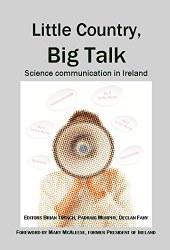- Book or article
Little Country, Big Talk: Science Communication in Ireland
Edited by Brian Trench, Padraig Murphy, Declan Fahly
Published by The Pantaneto Press
ISBN 978-0992941147
Book review by Andrea Bandelli, Executive Director, Science Gallery International, Dublin, Ireland
Science communication is broad discipline, it spans across media, journalism, education, civic engagement, policy, it is studied as an academic field of research, and it is at the same time a flourishing field of practice. It is also grounded in the cultural and historical context of the community where it is performed. Therefore it is quite difficult to get a “general overview” of what science communication actually means as a social activity. Some years ago the MASIS report attempted to give an analysis of the state of science communication at country level. These resources are invaluable, but also a bit “aseptic”, in the sense that they usually lack the personal accounts of the people who actually “do” science communication. They tend to look at what is achieved, and they forget the passions, motivations, hopes and disappointments of those involved.
The book “Little Country, Big Talk” does an excellent job at describing the multiple facets of science communication and why they matter. But in so doing it also presents powerful portraits of the people who dedicate their professional life to advancing a field that has seen huge transformations in the past 20 years.
The book is a collection of 19 short essays, which cover all the main domains of science communication. They give a true “360-degree” view of all aspects of society where science communication is relevant, from R&D policy and finance to tv documentaries and media, from journalism to education. The essays expose the well-known hurdles common in many other countries of limited resources dedicated to science communication, in the face of ample evidence of the benefits delivered by a healthy science communication field.
The introduction by Brian Trench is a masterpiece that weaves together the societal, political and cultural values of science communication. It gives a solid historical overview of how and why science communication came to be in Ireland, the role it plays in national R&D policy, education and media. I only wish we could have such overviews for many other countries: a good understanding of national contexts are essential for deeper collaborations.
Declan Fahy offers a critical overview of the fragile culture of science journalism in Ireland, which is struggling to provide the necessary commentary and reflection on the national ambitions in science and technology. The essay by Marie Boran is a timely account of how researchers use social media, and how an “always on” culture of communication impacts their performance and visibility in society. Padraig Murphy exposes the difficulties of tackling contested topics such as nuclear power and GMOs. Emma O’Brien testifies how public engagement can change the inward looking culture of research organisations, and can make them much more inclusive of public views. (As a personal note, it was extremely gratifying to read how Ecsite’s project FUND was instrumental in changing the organisational culture at BDI, The Biomedical Diagnostics Institute at Dublin City University).
Staying on the importance of public engagement, Brian Trench offers a comprehensive record of how science communication helps to build a culture of science. Comparing data from the Eurobarometer, the evaluation of ESOF 2012 and the Festival of Curiosity, Trench points to encouraging signs of how these initiatives effectively strengthen public interest in science. In the same essay, we learn also that one of Ireland’s most renowned scientists, Luke O’Neill, acknowledges the role of Science Gallery Dublin in giving him the skills to become a formidable science communicator and draw the crowds at his talks. How Science Gallery started is the subject of Ian Brunswick’s essay. Brunswick takes us on a deep-dive into the context that made Science Gallery possible: a forward looking university, entrepreneurial spirit and visionary people. An extended version of this essay is also available online.
These are just a handful of the essays, to give a glimpse of the richness of the whole book. They are all equally relevant, powerful and interesting. They take us on a journey to learn about the lives and passions of remarkable people who effectively created the field of science communication in Ireland. This book is an invaluable resource if you work in the field and collaborate with Irish institutions; and an outstanding example for other countries to follow.

